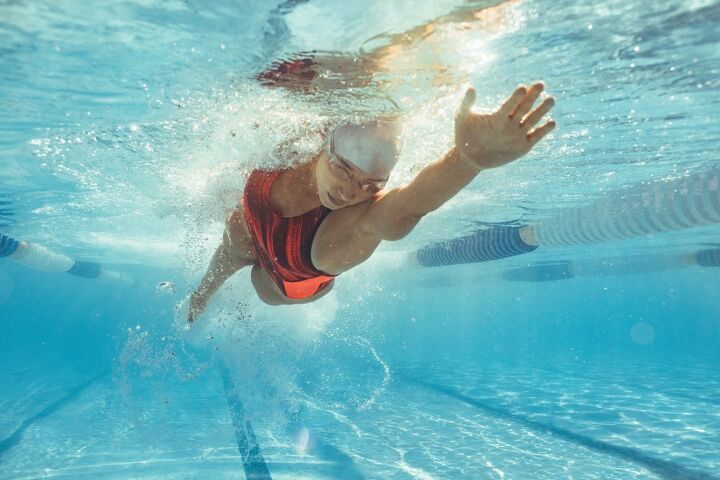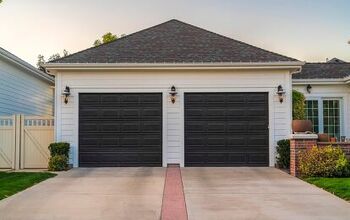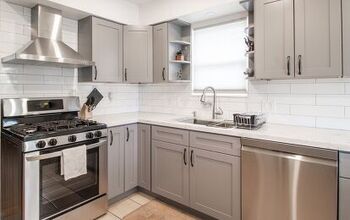Standard Lap Pool Dimensions (with Drawings)

Many people agree that having a pool in one’s own backyard takes homeownership to a whole new level. Both fun and functional, a backyard pool does not have to be humongous to be enjoyable. In instances where outdoor space is limited, a lap pool can be an excellent option.
Lap pools typically measure 40 feet long and fall anywhere from 6 to 10 feet wide. Pool builders recommend a depth of 3 ½ feet, and certainly not less than 4 feet if you do flips. This is, so swimmers do not scrape their hands and knees on the bottom while swimming.
Standard Lap Pool
A lap pool is basically a long, narrow, rectangular, in-ground pool, but there are some above-ground options. Depth, width, and length would depend on the space available as well as personal preferences. There isn’t too much variety with size and shape, but there are differing locations for the steps and benches.
Outward Steps and Bench
Standard lap pools measure 10 feet across and anywhere from 30-50 feet long. You can find the steps and a bench right in the middle and on one side of the pool. This works well for pools that do not graduate in depth, which is most lap pools.
This design works well when the pool is on the edge of a property facing a fantastic view. These 62 modern pool tile ideas will certainly turn heads.
Lap pools on the edge of a property could also be right beside a wall or fence. Hence, the steps and bench are easier to access from one side only. Make sure you know how unlevel an Intex pool can be.
Corner Steps
Lap pools with built-in corner steps are ideal for smaller-sized lap pools. A bench may or may not be present, but these pools certainly do the job for any serious swimmer. Corner steps maximize the space needed for exercise, which makes these pools ideal for that daily swim.
Edge Steps and Bench
Another placement for the steps and a bench are across from each other on either side of the pool’s length. These are great areas for smaller children to hang out while always supervised.
This bench and step placement also work for pools that get progressively deeper. More often than not, steps start on the shallow end while the bench is on the opposite, deep end. While most lap pools remain at a steady depth, a few do graduate in depth from 3 feet to 6 feet.
Types of Lap Pools
Above-Ground Pool as a Lap Pool
An above-ground pool is a great alternative when considering a pool in the backyard. One commonly known advantage of an above-ground pool is the significant price difference compared to a traditional pool. With no government permits and excavation costs involved, an above-ground pool is truly a reasonable alternative.
Inground pools require the services of professional pool installers and contractors, while many above-ground pools come with a do-it-yourself installation kit. Even better, when purchasing an above-ground pool from a local pool shop, installation often is included in the cost.
This above-ground pool pictured below is slightly wider than a typical lap pool and marginally shorter. However, you could use it as an exercise pool, especially if you employ the use of a swim tether. There are also above-ground pools that measure 32 feet long, although they are typically wider than average.
Using a Swim Tether
A swim tether is a device used to strap you in place while swimming. One type of tether is the foot tether, and the other is a resistance belt. The resistance belt straps around your waist while the foot tether is strapped to one of your ankles.
Used for resistance training, swim tethers allow you to swim in place while building up strength and endurance. A swim tether is a fantastic tool to use when your pool is not big enough for numerous laps.
Spool Pool
A spool pool is a swimming pool and a spa hot tub rolled into one. If you desire a pool yet your backyard and budget are limited, a spool pool would be an excellent option. Spool pools work as an all-in-one backyard feature that incorporates fun, exercise, and relaxation.
Spool pools are typically 10-16 feet long and 6-8 feet wide and can be installed in or above-ground. When fitted with powerful whirlpool jets to create resistance currents, this pool turns into a cardio machine while you swim. The jets also create a spa-like ambiance when you sit still, allowing the currents to soothe sore muscles.
Despite its size, a spool pool can give you a total body workout. It is certainly more substantial than a hot tub and is also not difficult to install either indoors or outdoors. Aside from the fast installation, a spool pool is significantly easier on the pocket than a lap pool.
Plunge Pool
A plunge pool is typically a small pool that is 4 – 8 feet deep, 6 feet being the most popular option. It is a water feature where you plunge your entire body in to cool off during the sweltering summer months. Most plunge pools are less than 10 feet long, making them a perfect addition to a tiny backyard.
A plunge pool works very well as both a decorative and functional piece when you have limited lawn space. You may not be able to do laps in a plunge pool due to its diminutive size. However, installing a swim tether would give you the ability to utilize your plunge pool for exercise purposes.
A plunge pool may lack the wow factor of a traditional pool, but you can easily remedy this drawback. A water feature, such as a fountain or strategically placed plants, goes a long way to beautify a space. Colorful, non-traditional tiles in and around your plunge pool and unique deck chairs also contribute to sprucing up the area.
Lap Pool Care and Maintenance
Just because you have finally outfitted your backyard with a lovely swimming feature does not mean the work ends there. In fact, regular maintenance of your pool is key to ensuring that it stays clean and hygienic for use. Here are some steps to simple and basic pool maintenance.
Skim the Surface
Debris constantly accumulates on the water’s surface, and removing this matter daily is a necessary task. Taking a few minutes out of your day to skim leaves, insects, and other material from the water is all it takes. This simple task allows you not to have to deep clean more often than is necessary.
Use a net with an extendable pole and skim the surface of the water from one end to the other. When done, shake off the accumulated debris on a grassy area before placing the net back in the water. This daily ritual will help prevent dirt and organic matter from sinking to the bottom of the pool.
Brush the Walls
Pool walls need to be scrubbed and brushed to discourage algae growth and remove chemical residue and dirt. Attach a pool brush to an extendable pole and brush the sides, steps, and ladders. You don’t need to brush the pool daily unless there is significant dust and debris around the pool area.
Take time and do not skip tight spaces or corners while brushing. Brushing pushes stuck dirt and algae into the water, making it easier work for your pool vacuum or chemicals. Rinse the brush clean and put it away when done.
Vacuum the Floor
Before the advent of self-cleaners, a manual vacuum was a necessary part of your pool cleaning arsenal. Attach the vacuum head and hose to your extendable pole to suck up dirt and debris from the bottom of your pool. Lower the vacuum to the bottom and push the other end of the hose against a jet to eliminate air.
Once your vacuum is ready, glide slowly against the bottom of the pool. Do not rush through this job, as this will encourage debris to swirl up from the bottom of the pool. Remember to turn off the filtration system while vacuuming and turn it back on when you’re finished.
If skimming leaves, scrubbing walls, and vacuuming is a little too much work, invest in an automatic pool cleaner. It may be a trifle expensive, but it will certainly do the job while you enjoy a refreshing cocktail.
Clean the Filter
Much like an air conditioning or heating system, cleaning around it would not be effective if you forget the filter. No amount of scrubbing or vacuuming is helpful if you fail to clean out your pool filter. Remember to abide by the manufacturer’s recommendations when cleaning your filter, as there are different types depending on your pool.
Don’t Forget the Deck
Before the scrubbing or vacuuming commences, sweeping the deck is always a good start. The deck surrounding your pool may be littered with dead leaves, grass clippings, and other lawn debris. Cleaning your pool and not your deck would just have all that debris end up in the water.
Start by sweeping the area with a broom, or better yet, use a leaf blower if one is available. Next, spray the area with a hose or a pressure washer to remove stuck dirt and debris. Occasionally, you will need to deep-clean your pool deck with a commercial deck cleaner and a stiff brush.
Related Questions
What is the price difference between an inground pool and an above-ground pool?
For a standard-sized pool, an inground pool with a patio would cost you $30,000 – $70,000. An above-ground pool of similar size would cost $4,000 – $12,000, not including the deck. Both types may offer the same swimming area, but an above-ground pool is harder to clean without a deck.
What is the lifespan of an above-ground pool compared to one inground?
Typically, an inground pool can last you decades, while an above-ground pool may only be good for about 7-15 years. However, one advantage of having an above-ground pool is that it is relatively easy to take apart and disassemble. This is certainly not the case with an inground pool.
Summing It Up
Regardless of the type of pool, having one in your backyard will provide much entertainment for your friends and family. Identify what kind of pool would be most beneficial for you but keep in mind space limitations and budget considerations. When done deliberating, jump right in; the water’s fine.

Stacy Randall is a wife, mother, and freelance writer from NOLA that has always had a love for DIY projects, home organization, and making spaces beautiful. Together with her husband, she has been spending the last several years lovingly renovating her grandparent's former home, making it their own and learning a lot about life along the way.
More by Stacy Randall
































